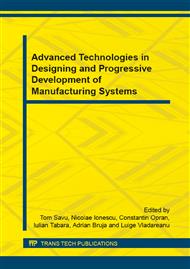[1]
M. Adams; N. Bogduk; K. Burton; P. Dolan, (2006), The Biomechanics of Back Pain Second Edition, Churchill Livingstone Elsevier.
Google Scholar
[2]
Veronica Argeșanu, Ergonomia echipamentelor și departamentelor medicale, Editura Eurostampa, Timișoara (2004).
Google Scholar
[3]
I. S. Borozan; R. M. Kulcsar; Vertebral column bioengineering analysis at bending and torsion, International Conference on Human-Machine Systems, Cyborgs and Enhancing Devices HUMASCEND, Iasi, Romania, June 14-17, (2012).
Google Scholar
[4]
L. Brîndeu, C. Popa, C. Ştefan, A. Hegedus, Identification of Human Body Model, Sitting on a Vehicle Chair, 3th. Mini. Conf. on VSDIA, Budapest, Nov. 6-8, (2000).
Google Scholar
[5]
Diana E. De Carvalho, Jack P. Callaghan, Influence of automobile seat lumbar support prominence on spine and pelvic postures: A radiological investigation, Applied Ergonomics, Elsevier, (2012).
DOI: 10.1016/j.apergo.2011.12.007
Google Scholar
[6]
B. Hinza, H. Seidel, The significance of using anthropometric parameters and postures of European drivers as a database for finite-element models when calculating spinal forces during whole-body vibration exposure, International Journal of Industrial Ergonomics, Elsevier, (2008).
DOI: 10.1016/j.ergon.2007.10.022
Google Scholar
[7]
Seokhee Naa, Sunghyun Limb, Hwa-Soon Choia, Min K. Chung, Evaluation of driver's discomfort and postural change using dynamic body pressure distribution, International Journal of Industrial Ergonomics, Elsevier, (2005).
DOI: 10.1016/j.ergon.2005.03.004
Google Scholar
[8]
M. Ververa, R. de Langea, J. van Hoofa, J. S. H. M. Wismans, Aspects of seat modelling for seating comfort analysis, Applied Ergonomics, Elsevier, (2005).
DOI: 10.1016/j.apergo.2004.09.002
Google Scholar
[9]
R. Zenk, M. Franz, H. Bubb, P. Vink, Technical note: Spine loading in automotive seating, Applied Ergonomics, Elsevier, (2012).
DOI: 10.1016/j.apergo.2011.06.004
Google Scholar
[10]
** http: /robofun. ro.
Google Scholar
[11]
** http: /www. anybodytech. com.
Google Scholar


